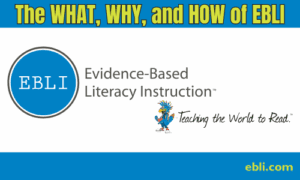How Might I Identify A Pretend Reader (and Speller)?
In our reading center, parents often ask us how their child got all A’s on their report card but really can’t read or write.
My daughter Colleen was the best reader in her class in 1st grade and the beginning of 2nd grade, according to her teachers. She was fluent and accurate, sounding like a beautiful reader when reading books taught in class. She also got 100% on every spelling test.
In reality, she was a poor reader and a horrific speller.
IDENTIFYING PRETEND READING
In 2nd grade, Colleen tested a year below grade level on the reading portion of the Iowa test (but in the 98th percentile in math – well above grade level). She could not read any book or story she hadn’t already memorized and couldn’t even accurately read a sentence pulled out from a book or story she had memorized.
In her classroom, the audiotape of the story was read to the class, then the teacher read it to the class, then the students spent the week reading the story. Colleen thought looking at the ceiling while ‘reading’ the story was a great trick.
Colleen was a pretend reader. She could recite books from memory but she couldn’t actually read the words. She was a ‘rote memory’ speller. She could memorize the words for a spelling test but she couldn’t spell the same words in her writing. Are you familiar with children like this?
A more common strategy ‘pretend readers’ use is to look at the picture to figure out what might be written on the page but say words that aren’t on the page (‘bunny’ for ‘rabbit’ or ‘little’ for ‘small’). Pretend readers often look at the first letter of a word then guess, saying a different word that starts with the same letter (‘stop’ for ‘spot’ or ‘pretty’ for ‘print’). It is very common for pretend readers to misread the connecting words that occur frequently in text (‘and’ instead of ‘said’ or ‘when’ instead of ‘went’).
Typically, the pretend readers misspell words in writing even more than they misread words when reading. Reading and spelling are two sides of the same coin, using the same code, but spelling is much more challenging. Sometimes a child will do well on spelling tests if they can memorize the string of letter names for the word, but then misspell the same words from the test when writing. They often spell phonetically, writing ‘skul’ for ‘school’ or ‘wuz’ for ‘was’.
Pretend readers may comprehend the text, especially in early grades when using simple pattern books. In these books, most or all the words repeat on each page except for one. There is a picture to represent the word that is changed so the child can look at the picture to figure out what the word is instead of reading it. If a student has re-read the story or book many times and has memorized it – like Colleen did – they will comprehend the information.
However, most pretend readers do not understand what they read. If they are not reading the words written on the page, then comprehending what they read is not possible. For example, if they say “I saw a beautiful butterfly” but the words on the page are “I saw a bouncing basketball,” they will assume the sentence is about a butterfly, not a basketball. As students move past K and 1st grade, they have more trouble reading the words accurately and getting the gist of the text. Third grade is most commonly when struggles accelerate significantly with both reading and spelling.
How Do Students Become Pretend Readers and Spellers?
Children go to school expecting to magically become readers and writers. Teachers and parents are eager for children to quickly begin reading and writing. Often that enthusiasm results in deemphasizing or avoiding instruction in the foundational skills, concepts, and information needed to accurately decode/decipher words and encode/spell words. Learning to read and spell in order to become proficient readers and writers requires significant effort. Commonly this instruction and effort is bypassed in hopes of students arriving more quickly at comprehension and writing. While that may appear to work somewhat in the short term, it will backfire for the majority of students in the long run.
Getting to the end goal of reading (understanding what you’ve read) can be compared to the process of getting to the end goal of driving a car or living in a house: there are components that must be in place before you can have the pleasure of the finished product. If the car doesn’t have an engine or the house doesn’t have a foundation, the exterior may look lovely, but you’d have a worthless car or an unstable house.
The same is true for reading as well as spelling. The ‘engine’ or ‘foundation’ of reading is matching the letters in the words on the page to the sounds that those letters represent in speech. For example, when a reader sees the word was, they need to accurately match the sounds to the letter(s) – /w/ (spelled with a ‘w’), /u/ (spelled with an ‘a’), and /z/ (spelled with an ‘s’) – and then blend the sounds into a word.
After using this process to decode a specific word a few times, the word can then be read automatically without the need of sounding it out. This is the ‘engine’ or ‘foundation’ of reading. Over time the alphabetic code is learned, from simple to complex, through explicit instruction and then helping a student apply what was learned as they read and write.
For spelling, the inverse is true: there is a blank page that requires writing down the letter(s) that represent the sounds in the words. When spelling phone, a learner must know that the /f/ sound is represented with ‘ph’, the /oa/ sound is represented with ‘o’, and the /n/ sound is represented with ‘ne’. Spelling is a much more daunting task and takes longer to master than reading! You may know (or be) a good reader who is a poor speller, but you will be hard pressed to find a good speller who is a poor reader.
The English alphabetic code used for reading and writing is extremely complex. An understanding of this code is imperative in order to establish a firm foundation for reading and spelling.
For pretend readers and spellers, this foundation is weak or missing altogether. They don’t have any idea that reading is based on the English alphabetic code and rarely have they been shown the logic of the code or how to apply it. I’ll delve deeply into the concepts and logic of that code in our March 2021 blogs and webinar on How to Teach Reading Well and Quickly.
Children (or adults) who have a weak understanding or knowledge of this code fall back on ineffective strategies they’ve figured out or been taught in an attempt to muddle through reading and writing. As they get older, the complexity of the text they are expected to read (or write) increases. There are no more pictures to rely on to try to figure out the words and there are too many words to memorize or try to guess. The effort required to manage increasingly difficult text engulfs and overwhelms these learners as they fall further behind each school year. Comprehension becomes more and more compromised; spelling and writing become increasingly impossible.
How Do I Know if a Child is Pretend Reading or Spelling?
If you want to check and see if a child is pretend reading versus really reading, give them an unfamiliar book that is appropriate for their age or ability level. Ask them to read it to you. If there are pictures in the book, cover the pictures. Pay attention to their accuracy in reading the words and how they approach unfamiliar words.
To check their spelling, ask them to write you a sentence to a paragraph, depending on their age and ability level. Note the accuracy – or inaccuracy – of their spelling, punctuation, and capitalization as well as handwriting.
How Do Students Become Accurate Readers and Writers?
The cure for sub-literacy – reading, writing, and spelling below one’s potential – is not just instruction but instruction that works. Explicit, effective, efficient instruction in the essential components of reading (phonemic awareness, phonics, vocabulary, fluency, and comprehension), and writing (spelling, handwriting, and writing composition), based on the Science of Reading, is imperative. This instruction must start with the foundation, which is the logic and application of the skills, concepts, and information to manage the English alphabetic code. It must be intertwined with explicit instruction in all the components of literacy. Ideally, learners will utilize and apply what they’ve been taught via supported reading in text and spelling in writing. Receiving feedback and error corrections as needed is another crucial component on the student’s journey to becoming an accurate, automatic, high level reader and writer.
Abolishing ineffective, inefficient habits that hinder reading and writing is also necessary. Practice in guessing words, looking at the picture, over-reliance on rules, using inventive spelling, and writing without punctuation, capitalization, or conventions quickly become engrained habits and inhibit accurate reading and spelling. Register for our Pretend Reading webinar to learn some techniques on how to help students get rid of these habits.
Reading words in text accurately and automatically as well as spelling and writing accurately are the building blocks that lead to high level literacy for all.
Have you seen pretend reading in action with your student(s)? What are you doing to combat pretend reading? Share in the comments.





